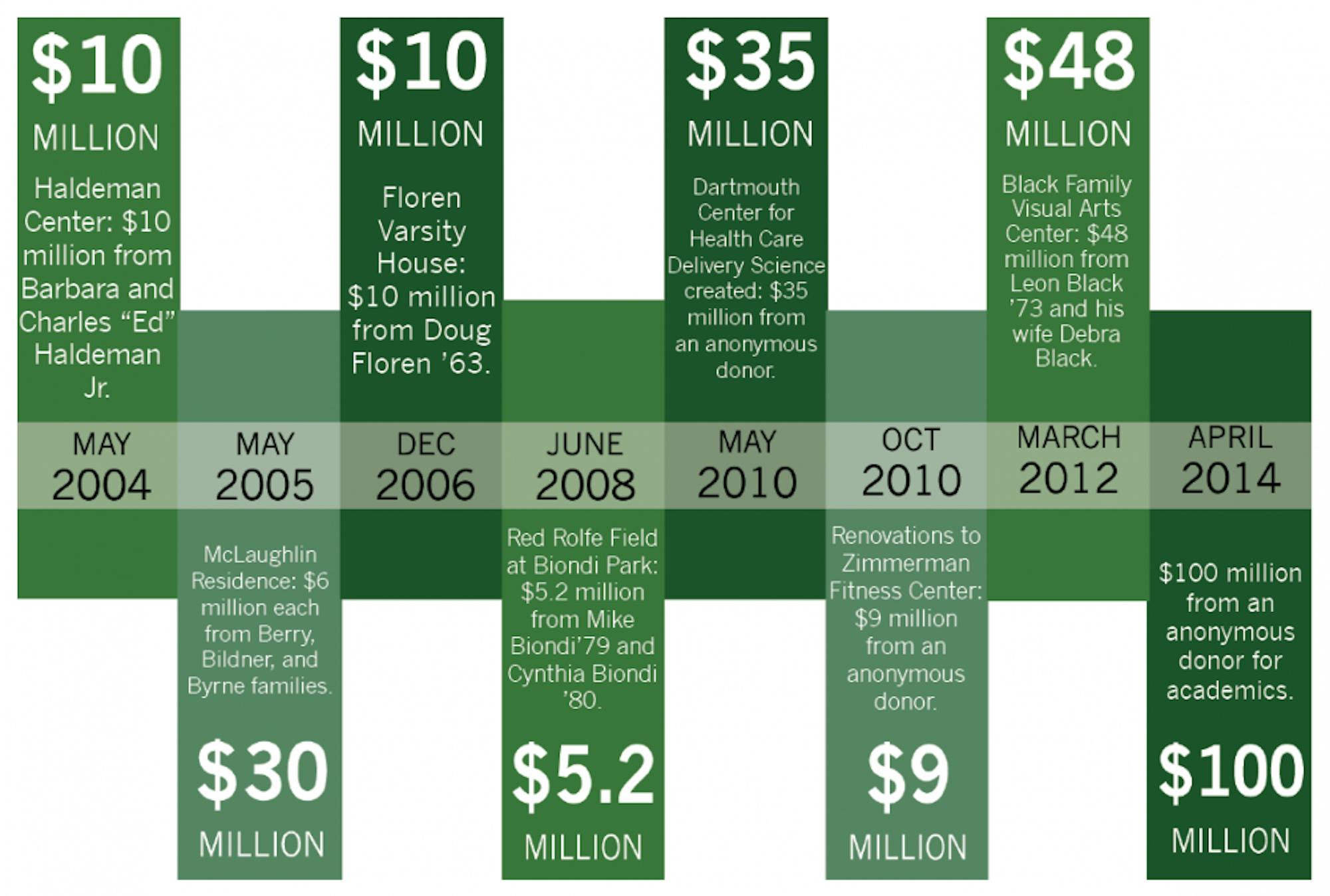In February 1904, Dartmouth Hall burned down in a smoky blaze. In response, Melvin Adams, Class of 1871, rallied the College’s New England alumni and raised enough money to begin rebuilding Dartmouth Hall within three months.
Though the recent $100 million gift to the College was unprecedented, it follows a rich history of alumni giving, with Dartmouth’s donation rate sitting second highest in the Ivy League at 44.5 percent in 2013, behind that of Princeton University. For comparison, the 2005 fiscal year saw a total of $106,214,533 in donations.
Ted Grossnickle, senior consultant and founder of Johnson Grossnickle Associates, identified three driving factors behind particularly large gifts — considerable belief in a college’s mission statement, trust in the institution’s leadership and a strong sense of connection to the school.
Substantial gifts are usually given when leaders at a college have an “overpowering or overwhelming” vision that relates to the donor’s own values, higher education fundraising expert Arthur Criscillis said.
The recent donation also comes with a two-to-one matching mechanism, which requires the College to raise money on its own for any projects that it hopes to fund with money from the donation. If a proposal costs $30 million, for example, then Dartmouth must raise $20 million before $10 million can be accessed from the donated funds.
Criscillis said such models are common among higher education donations and usually produce effective results.
“It’s a way to heighten the impact of the gift that the donor made, and therefore further assist the implementation of the president’s vision for education,” Criscillis said.
Other large gifts to the College were used to fund for the Black Family Visual Arts Center, the McLaughlin residence cluster buildings, Floren Varsity House and the Haldeman Center. Chief operating officer for advancement Ann Root Keith said Dartmouth’s average alumni donation is $4,384.
The VAC, which opened in September 2012, was named in honor of Leon Black ’73 and his wife Debra, who contributed $48 million to the project. The center now contains the studio art and film and media studies departments, as well as a digital humanities program.
Studio art professor Louise Hamlin said it is “heaven” to have adequate space for creating and displaying art of any scale.
The VAC, studio art professor Colleen Randall said, has given students and faculty a collaborative space to share projects and ideas.
“For the first time, they have a space of their own,” she said.
The College also runs its own fundraising campaigns. In the early 1990s, the College spearheaded a large effort called “The Will to Excel Campaign,” which raised over $500 million. The College’s “Campaign for the Dartmouth Experience” raised $1.3 billion from 2002 to 2009 — money that helped complete several recent building projects, Keith said.
Grossnickle and Criscillis said large gifts are typically restricted. Although the recent $100 million donation is not completely unrestricted, its missions to “support academic excellence” and “strengthen [the College’s] ability to cluster faculty around areas where Dartmouth stands to have a profound impact on the world,” allow the administration to considerable flexibility in its use.
Since 2004, the College’s annual total giving has grown by an average of 7.76 percent per year. Last year, Dartmouth alumni, parents and friends made gifts totaling $163,756,387, with 66.3 percent of the money coming from alumni, Keith said.
2014 marks the 100th anniversary of the Dartmouth College Fund. In recognition of this special occasion, Keith said, 46 women have pledged gifts of $100,000 each to join the Centennial Circle, a giving society which hopes to reach 100 women donors.
Aside from directing money toward construction projects and renovation, Keith said, many gifts also endow professorships, which fund a professor’s salary.
Government professor John Carey, who is currently endowed with the John Wentworth Professorship in the Social Sciences, said that the title is largely honorary but signifies the donor’s “selfless” act, as the donor did not choose to name the professorship after himself.
The Dartmouth College Fund reports that over 5,000 alumni have contributed every year since graduation.




